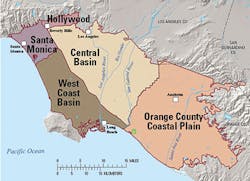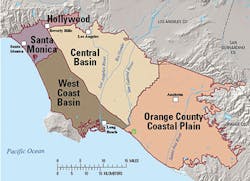By Douglas Wance, Howard Ellman, and Kimberly Huangfu
In an effort to balance depleted groundwater supplies in California amid record drought conditions, Governor Jerry Brown signed three bills on September 17, 2014, designed to regulate groundwater aquifers throughout the state. This landmark legislation, as Senator Pavley stated, "embraces the concept that groundwater is best managed locally."
However, although operating under the guise of increased transparency, the Act fails to address several key issues, leaving an aura of uncertainty and the future of the state's groundwater systems hanging in the balance. Nearly eight months since its enactment, confusion continues to reign as groundwater pumpers and water managers attempt to navigate uncharted waters.
Through a trinity of groundwater legislation, Senate Bill 1168, Assembly Bill 1739 and Senate Bill 1319 -- collectively the Sustainable Groundwater Management Act (Act) -- California enacted an ambitious framework to regulate and monitor groundwater basins -- a precious resource that provides up to 60 percent of California's total water supply in dry years.
This marks the beginning of a critical chapter in the ongoing water saga for the state, in stark contrast to the traditional paradigm that has focused primarily on the management of surface water. Although highly controversial, the Act has been deemed by some to be a step in the right direction and a remarkable shift away from California's traditional laissez-faire approach to groundwater management. Though guardedly optimistic, many still believe that the fate of the state's water crisis remains unclear.
For the first time in California law, the Act establishes the concept of groundwater sustainability agencies (GSAs) consisting of a self-appointed entity comprised of one or more local agencies that hold water supply, water management or land-use responsibilities within a groundwater basin. Public utilities and mutual water companies -- key players that provide water services to approximately 5.5 million constituents -- are excluded by definition from the list of those agencies that are eligible to become GSAs.
The Act grants GSAs wide latitude to oversee the allocation of vested water rights, as well as the authority to allocate groundwater supplies between competing interests within the GSA's jurisdictional boundary, in addition to the power to regulate, limit or suspend groundwater extractions.
Although implementation will prove challenging, the Act provides the following framework that has been the subject of considerable scrutiny:
- The Department of Water Resources (DWR) is required to prioritize the list of all groundwater basins and to classify each basin as a high, medium, low, or very low priority based on the following considerations: population; extent of public wells; overlying irrigated acreage; reliance on groundwater; any documented impact to the basin from overdraft, subsidence, saline intrusion, and other water quality degradation; and any other information determined to be relevant, such as adverse impacts on local habitat or local stream flows (Cal. Water Code § 10933(b)).
- GSAs are then mandated to adopt a groundwater sustainability plan (Plan) and submit it to DWR by January 31, 2020, for all high- or medium-priority basins with serious overdraft conditions, or January 31, 2022, for all other high- or medium-priority basins, unless the basin has been adjudicated or the GSA asserts that the basin is being sustainably managed. Although encouraged, low- and medium-priority basins are not required to prepare a Plan (Cal. Water Code §§ 10720.3(a), 10721(b), 10722).
Envisioned as stewards of the future of California's groundwater, GSAs are granted the power to collect information relevant to groundwater management through the acquisition of land and water to carry out the Plan, including but not limited to spreading, storing, retaining, percolating, transporting, or reclaiming water to recharge the basin or provide water supplies in lieu of groundwater; the ability to monitor for compliance and impose limits on groundwater extractions; and the assessment, imposition and enforcement of fees against pumpers to fund the Plan. The Act has real teeth in that GSAs can impose extraction allocations, which in turn could limit a pumper's ability to extract groundwater in accordance with an existing water right.
GSAs are also commissioned with the authority to adopt rules, regulations, ordinances, and resolutions for the purpose of achieving the goals specific to that particular basin. Perhaps more alarming, however, is a GSA's ability to regulate, limit or suspend the extraction of groundwater from individual or multiple wells. This curtailment "authority" has the potential to be implemented arbitrarily because the Act provides no guidance as to the basis upon which a GSA should render decisions with respect to permitted water usage within the basin.
Whether an agency should base its allocation determination on historical extraction records, vested water rights, land ownership, current use, or other tangential metrics, or whether priority should be given to one factor over another remains unsettled. Once an allocation has been mandated, the GSA can require groundwater users to implement temporary or permanent transfers of their allocation, essentially divesting groundwater users of certain perfected rights without adequate due process.
On its face, the Act is ambiguous as to the intersection between common law groundwater rights, future land use planning, and the policy objectives emphasized in the Act relating to sustainability and reliability over a 50-year horizon. On the one hand, it states that "[n]othing in this part, or in any groundwater management plan adopted pursuant to this part, determines or alters surface water rights or groundwater rights under common law" (Cal. Water Code § 10720.5(b)).
In reality, however, it is difficult to reconcile this proclamation with the substance of the Act, which consists of legislation that grants GSAs the overarching authority to establish groundwater management plans that may very well conflict with traditional common law rules of groundwater rights in California that have, for centuries, hinged on the historical principle of "first in time, first in right" and the priority of overlying owners as to the groundwater under their land.
With competing water demands due to drought conditions in the late 1930s, courts devised a formal adjudication process to "legally" reapportion and effectively reduce existing water rights if the basin was found to be in overdraft. As codified, the Act's statutory framework appears to circumvent the adjudication process that the courts devised to "equitably" reapportion and effectively manage water rights if a basin was found to be in overdraft.
This approach steers those with groundwater rights into dangerous terrain given the Act's strong deference to the GSAs. As such, all groundwater pumpers and overlying landowners must proceed with caution and remain vigilant in protecting their respective groundwater rights. Groundwater rights holders, pumpers and overlying landowners may find themselves the biggest losers in California's uncertain and perpetual water drama.
Douglas Wance is chair of Buchalter Nemer's Land Use Practice Group and a shareholder in the Real Estate Practice Group in the Orange County office. He can be reached at 949.224.6439 or at [email protected].
Howard Ellman is a shareholder in Buchalter Nemer's Land Use and Real Estate Practice Group in the San Francisco office. He can be reached at 415.296.1610 or at [email protected].
Kimberly Huangfu is an associate in the Government, Land Use, Environment and Energy Group at Jeffer Mangels. She can be reached at [email protected].
More WaterWorld Current Issue Articles
More WaterWorld Archives Issue Articles




